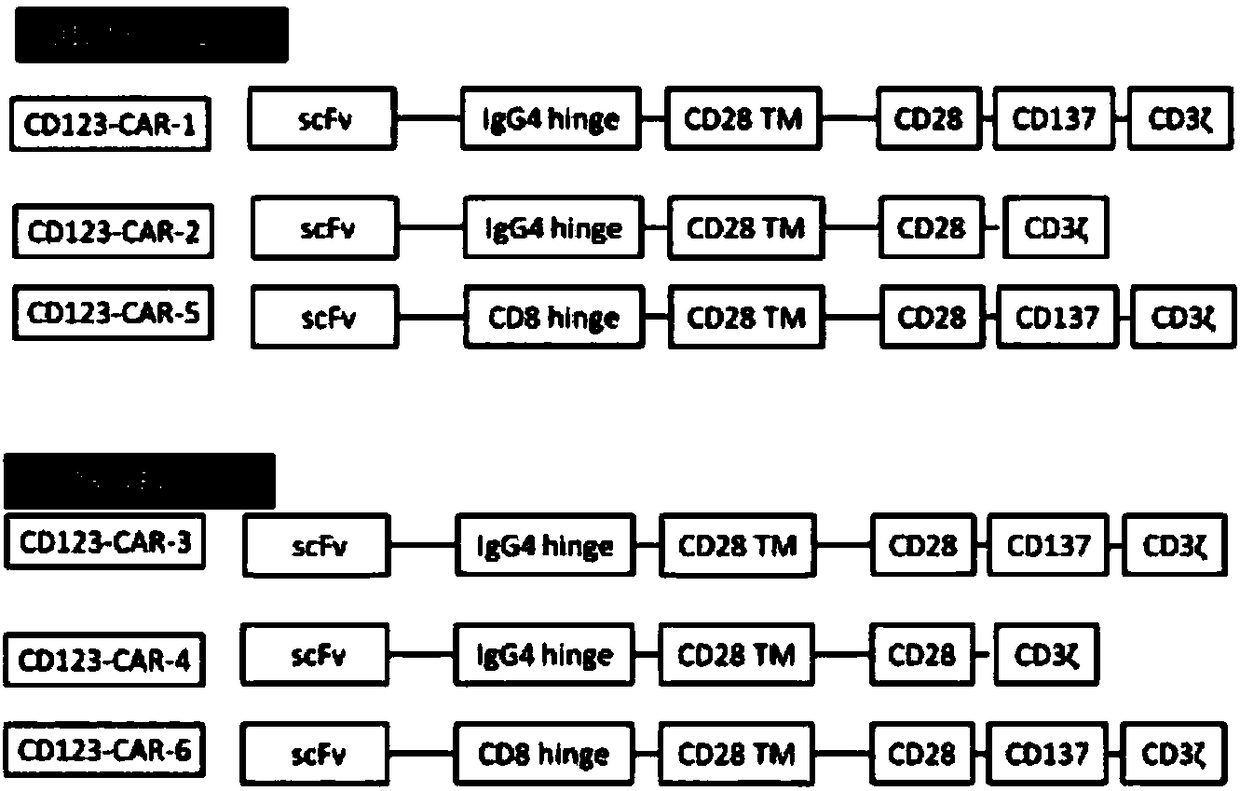Anti-CD123 (anti-cluster of differentiation 123) single-chain antibody, chimeric antigen receptor combined by same and application thereof
A technology of chimeric antigen receptors and single-chain antibodies, applied in the field of genetic engineering, can solve the impact of no reports showing stable CD123 myeloid tumor curative effect, no good solution for the stability of antigen chimeric receptors, and efficacy Limited safety and other issues, to achieve the effect of strengthening the ability to proliferate and kill tumors, no toxic and side effects, and a wide range of choices
- Summary
- Abstract
- Description
- Claims
- Application Information
AI Technical Summary
Benefits of technology
Problems solved by technology
Method used
Image
Examples
Embodiment 1
[0058] Example 1 Construction of Chimeric Antigen Receptor Virus
[0059] In order to screen better CAR combinations, the following 6 chimeric antigen receptors need to be constructed:
[0060] CD123-CAR-1, CD123-CAR-2, CD123-CAR-3, CD123-CAR-4, CD123-CAR-5, CD123-CAR-6.
[0061] 1. Synthesize the gene sequence of chimeric antigen receptors targeting CD123 containing different scFvs and synthesize different single-chain antibody ScFvs containing leader peptide (also known as signal peptide) (abbreviated as LP) and anti-human CD123 antigen in turn, IgG4 hinge region (abbreviated as IgG4), CD28 transmembrane region or CD8 transmembrane region (abbreviated as TM), its structure is as follows figure 1 shown.
[0062] 2. Construction of lentiviral vectors expressing chimeric antigen receptors
[0063] 1) Design the following primers and synthesize them by Nanjing GenScript Biotechnology Co., Ltd. The specific primers are as follows:
[0064] Primer 1: 5'-ag gctagca tgggatggagct...
Embodiment 2
[0080] Example 2 Detection of Chimeric Antigen Receptor Transfection Efficiency in T Cells
[0081] 1) Isolation of human peripheral blood mononuclear cells
[0082] Collect about 60ml of peripheral blood with anticoagulant-added blood collection tubes, divide into 30ml of 50ml centrifuge tubes, add 7.5ml of hydroxyethyl starch to dilute; naturally settle at room temperature (18-25°C) for about 30min, collect the upper layer of plasma, and The collected upper plasma was centrifuged at 1400rpm / min for 15min; then the pellet was resuspended with normal saline, added to the lymphocyte separation medium at a volume ratio of 1:1, gradient centrifuged at 400g / min, and the speed of the centrifuge was set to 1 , centrifuged for 20min; after centrifugation, the centrifuge tube was divided from top to bottom: the first layer: plasma layer; the second layer: annular milky white lymphocyte layer; the third layer: transparent separation liquid layer; the fourth layer: red blood cell layer;...
Embodiment 3
[0085] Example 3 Detection of the positive rate of CAR molecules and the ratio of CD4 and CD8
[0086] CD123-CAR-T cells cultured for 11 days were centrifuged at 300g / min for 5min, discarded the supernatant and resuspended with 1ml PBS, repeated this step twice, then added labeled CD3, CD4, CD8 (BD company) and The flow detection antibody of Protein-L (Beijing Yiqiao Shenzhou Co., Ltd.) was incubated at 4 degrees for 30 minutes, washed 3 times with PBS, and then AF647-labeled mouse anti-Protein-L antibody (Nanjing GenScript Company) was added, and incubated at 4 degrees for 30 minutes. Wash twice with PBS for 1 minute, discard the supernatant, add 200ulPBS to resuspend the marked cells, and perform flow cytometry results as shown in Table 1 and image 3 shown.
[0087] Table 1 CD4 / CD8 flow cytometry results and statistical results of different CD123-CAR-T cells
[0088] CAR name
PUM
 Login to View More
Login to View More Abstract
Description
Claims
Application Information
 Login to View More
Login to View More - R&D
- Intellectual Property
- Life Sciences
- Materials
- Tech Scout
- Unparalleled Data Quality
- Higher Quality Content
- 60% Fewer Hallucinations
Browse by: Latest US Patents, China's latest patents, Technical Efficacy Thesaurus, Application Domain, Technology Topic, Popular Technical Reports.
© 2025 PatSnap. All rights reserved.Legal|Privacy policy|Modern Slavery Act Transparency Statement|Sitemap|About US| Contact US: help@patsnap.com



